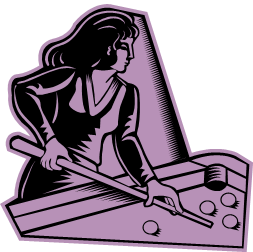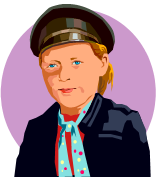Joe Waldron
Pocket Billiards Review
January 2009

One of the most persistent problems in pool is standing up on a shot. Everyone does it, f rom pro to amateur. Standing up ruins perfect aim, follow through, and whatever spin was placed on the cue. If everyone, or nearly everyone, does it there must be some inherent reason that apply and there should be some ways to overcome this perennial problem.
You can be playing along for hours and never stand up on a shot. Then all at once it begins to happen. The first two or three times you don’t even know that you are standing up. If you are lucky, a friend will tell you the first or second time. It is interesting to me how often this phenomenon happens: we stand up and don’t realize it at the time, or after it happens. By about the third really stupid miss and with a great deal of mental instant replay of the shot a light comes on “Ahh — I stood up, that’s why I missed.” Of course, you don’t stand up on every shot or every time you miss, that is one of the things that makes it so difficult to recognize. In addition to all of the above problems, you may not stand up very much, you may move just enough to miss. Standing up seems to happen when there is the most amount of pressure.
The “why” of standing up seems fairly obvious. It is when you are trying the hardest to play that perfect game. Something in our subconscious wants to see the shot, the roll, and the position come out exactly as planned. Of course if you are above the table you have a better view. In addition, when we put everything into the shot and really try to make the perfect play our whole body gets involved. Instead of just English, we also put a little “Irish.” You know what Irish is, that little nudge with your shoulder or twist of the hips after you hit the ball that in some mysterious way helps the ball in the pocket through telepathic communication. It seems sometimes that Irish helps!
What is to be done about this problem? First, if it is admitted that it is a subconscious process that is a function of trying your best, then a solution is readily at hand. The subconscious is, at times, like a little kid. He or she wants to do everything possible to help us but at times gets too enthusiastic and his help causes more problems than solutions. That is the problem to be addressed.

If we were working with a little kid who really wanted to help on some project we would set boundar ies around him so he would not hurt himself or us on the proje ct. If you are digging a hole you might give him a shovel, but you would not let him use the steam shovel. In addition, you might give him a task to do that was helpful but kept him out of harms way. That is the basic idea when working with the subconscious tendency to stand up on a shot. The analogy breaks down because while your subconscious is as enthusiastic as a little kid, it does not have the mentality of a child and needs to be provided with a “meaningful” task that assists in the making of a perfect shot.
Lets place boundaries around the subconscious so that he or she doesn’t mess up the shot, then lets find a truly meaningful task that does help in shot production. If it is difficult, or impossible, to stand up the phenomenon is unlikely to happen. Realistically, we can’t make it impossible. But we can make it so difficult that the difficulty itself will serve as a reminder to the subconscious not to engage in this behavior. Some sort of shift in body weight will make it difficult to stand up. Of course this has to become part of every shot so that it is automatic under the most pressured situation. You’ll need to practice this stuff or it won’t work when it is most needed.
The best way I have found is modeled after pistol shooters. Instructors teach shooters to “set their hips” as a way of stabalizing their body. Essentially, this means to drop your butt and thrust your hips slightly forward. The change in weight distribution firmly plants your weight on the back of your heels and makes if quite difficult to lunge into a shot. A similar technique is used by professional pool players who place the majority of their weight on their heels. We can take it one step further and roll the hips back. This sounds uncomfortable but it is not. Once you get used to it, you too will find that it is very seldom that you stand up.
Now for the meaningful work, if you use some technique such as the pistol shooter’s stance you can still be bothered by standing up on a shot. You don’t come up nearly as much as before because it is too difficult to move your body when it matters. However, there are other ways that the enthusiastic sub-conscious “stands up” and tries to and help. You may pick up your shoulders or your eyes. Perhaps the hands and arms get in on the act of using Irish. There are all sorts of weird things we do because of an excessively enthusiastic subconscious.
To teach your subconscious that the best thing it can do to help is to assist with “X” is the solution here. Now “X” can be variously defined but should always involve some mental process that you are working on; a fluid silky stroke, hitting center ball or following through. Whatever you are currently involved with in the improvement of your game is the trick. What is needed here is a heightened state of loose concentration.
Extreme focused concentration of the aim is probably best for my game. It can never do anything but make the game better. And so when I get down over the ball I try to place all of my concentration, and all subconscious assistance is certainly needed, to actually visualize the cue on line and at impact. When shooting I try to see the cue hit the object ball before I move anything. I have convinced myself that unless I see the actual hit I can not know what I did wrong for those “bad” shots. “Anyway,” I tell myself, “there isn’t anything you can do once the cue leaves the stick and the most important thing is to see if it hit exactly where intended.” The ball will (or not) go in the pocket, and the cue will (or not) go where intended whether or not I watch. Watching the hit tells me what I did right or wrong. This kind of reasoning can lead to a much improved game in which you will seldom stand up on a shot in a serious match. In the non-serious matches, I stand up all the time. Funny how old habits are difficult to get rid of.
By-the-way, there is an added advantage when attempting to see the hit on the object ball. I have a tendency to drop down after the shot to watch the exact line on which the cue travels. That is the kind of solution I was looking for, it works against standing up on a shot.
And so you ask, “Don’t you continue to stand up on a shot, sometimes?” Hell yes, unfortunately, I really am Irish by genetics and that can’t be trained out of the system.
